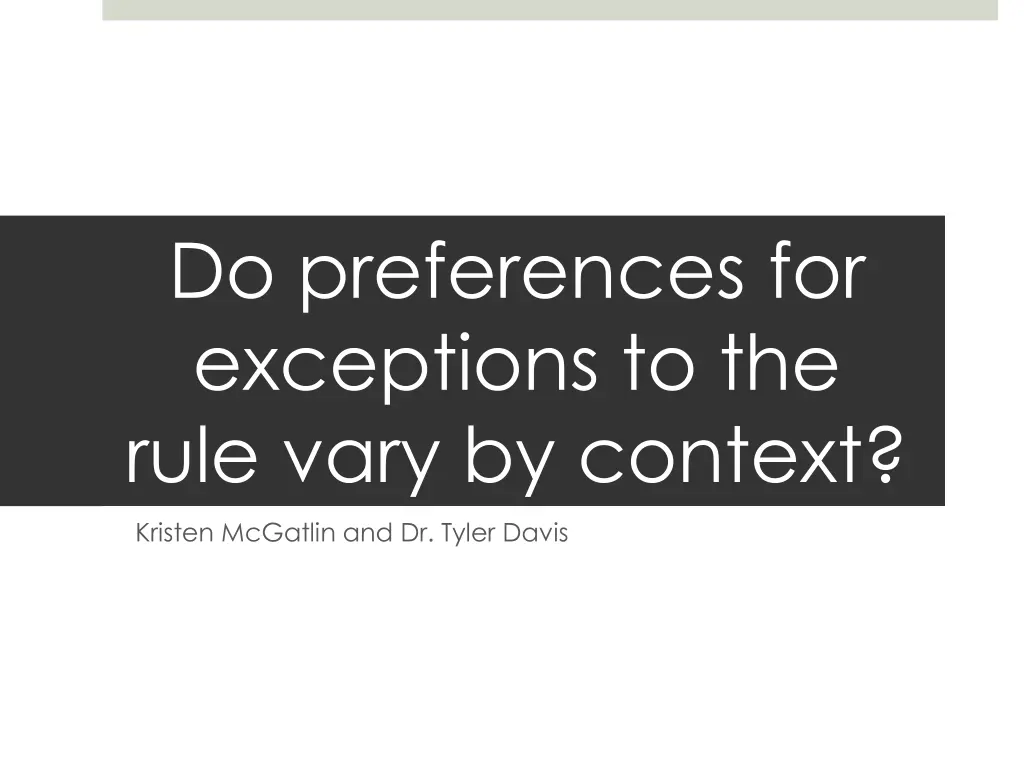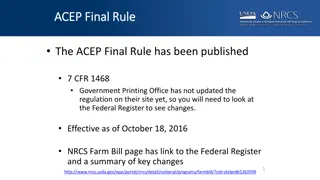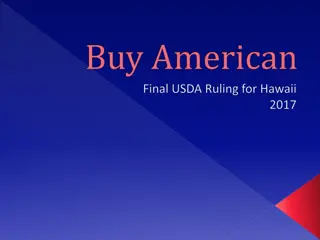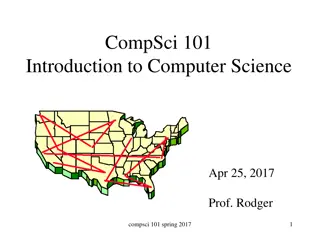
Preferences for Exceptions to the Rule Vary by Context
Explore the influence of context on preferences for exceptions to the rule, as discussed by Kristen McGatlin and Dr. Tyler Davis. Learn how familiarity, fluency, and other cognitive processes shape our liking for certain things, impacting decision-making and productivity in various settings. Discover competing theories on familiarity and fluency, and a solution to disentangle these ideas by studying exceptions to category rules. The purpose is to replicate research on learning categories and determine participants' preferences for exception items based on fluency and familiarity.
Download Presentation

Please find below an Image/Link to download the presentation.
The content on the website is provided AS IS for your information and personal use only. It may not be sold, licensed, or shared on other websites without obtaining consent from the author. If you encounter any issues during the download, it is possible that the publisher has removed the file from their server.
You are allowed to download the files provided on this website for personal or commercial use, subject to the condition that they are used lawfully. All files are the property of their respective owners.
The content on the website is provided AS IS for your information and personal use only. It may not be sold, licensed, or shared on other websites without obtaining consent from the author.
E N D
Presentation Transcript
Do preferences for exceptions to the rule vary by context? Kristen McGatlin and Dr. Tyler Davis
Why do we like what we like? While there is more that goes into liking something Subjectivity Cognitive processes?
Applied Importance? Work performance: preferred environment may cause less cognitive strain/stress = higher productivity Marketing: gravitate towards systems/products they like Equate preference with choice/decision making
Competing theories: Familiarity Exp. 1: Familiarity rating, distinctiveness rating, attractiveness rating Familiarity and distinctiveness negatively correlated Familiarity positively correlated with attractiveness Exp. 2: showed faces 6 times, then judgment phase Previously seen photos rated as more attractive Peskin & Newell, 2004
Competing Theories: Fluency Winkielman et al., 2006.
Problem Separating the two into actuallyseparate ideas Fluency correlated with familiarity
Solution: Exceptions to the rule Exceptions to category rules are more familiar and fluent depending on context, therefore able to disentangle the theories (Davis, Love, Preston, 2012)
Purpose Replicate previous research on learning categories Rule following items are categorized more accurately than exceptions Exceptions are recognized more accurately than rule following items Extend previous research Preference of the exceptions vs. rule following items
Question Will participants base their preferences of the exception items on 1. Fluency: exception preference determined by context 2. Familiarity: exceptions always preferred
Hypotheses: Fluency 1. Participants will prefer exceptions more during recognition tests than the rule following items, and vice versa during the test phase. 2. Participants will be better at recognizing but worse at classifying the exceptions.
Method 2 (stimuli type: fribble vs. squares) x 2 (phase order: categorization> recognition vs. recognition> categorization) N= 27 Mean age=24 13 Females, 14 Males Measuring Preference rating Categorization scores Recognition scores Reaction times
Stimuli Category 1Category 2
Procedure Learning Phase Recognition/Prefer ence Phase Category test/Preference Phase Recognition/Prefer ence Phase Category test/Preference Phase Recognition/Prefer ence Phase Category test/Preference Phase Category test/Preference Phase Recognition/Prefer ence Phase
Discussion What do we learn? Preliminary research suggests fluency is process behind preference formation Limitations: Rule hard to learn threw out 16 non-learners For future research, the participants may be given the categorization dimension before beginning to ensure high learning rats with less exclusion
Conclusion Exceptions found to be recognized faster and with greater accuracy than rule following items Extended previous research and found that preferences may be formed as a result of processing fluency, rather than familiarity
References Davis, T., Love, B., Preston, A. (2012). Striatal and hippocampal entropy and recognition signals in category learning: simultaneous processes revealed by model based MRI. Journal of Experimental Psychology: Learning, Memory, and Cognition, 38, 821-839 Peskin, M. & Newell, F. (2004). Familiarity breeds attraction: effects of exposure on the attractiveness of typical and distinctive faces. Perception, 33, 147-157 Winkielman, P., Halberstadt, J., Fazendeiro, T., & Catty, S. (2006). Prototypes are attractive because they are easy on the mind. Association for Psychological Science, 17, 799-806
ACKNOWLEDGNTS This material is based upon work supported by the National Science Foundation under Grant No. 1559393





















